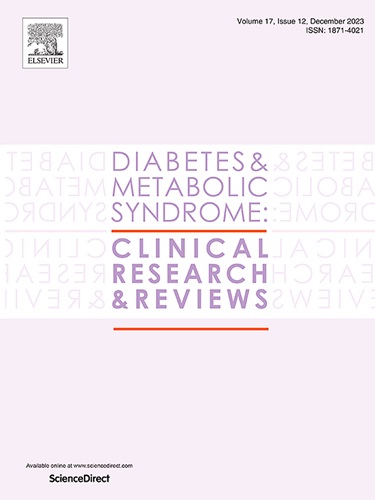微RNA-34a和启动子甲基化有助于2型糖尿病患者过氧化物酶体增殖激活受体γ基因的表达。
IF 4.3
Q1 ENDOCRINOLOGY & METABOLISM
Diabetes & Metabolic Syndrome-Clinical Research & Reviews
Pub Date : 2024-10-01
DOI:10.1016/j.dsx.2024.103156
引用次数: 0
摘要
目的:本研究旨在探讨DNA甲基化和miR-34a在调控2型糖尿病(T2D)患者过氧化物酶体增殖激活受体γ(PPARγ)中的作用:方法:我们使用甲基化特异性 PCR(MSP)和 RT-qPCR 分别研究了 84 例 T2D 患者中 PPARγ 启动子四个区域的甲基化状态和 PPARγ 的表达。此外,我们还通过 RT-qPCR 和 ELISA 分别量化了 DNA 甲基转移酶(DNMTs)的表达和全局 DNA 甲基化水平。我们通过干环 RT-qPCR 和 ELISA 分别测定了 miR-34a 的表达水平和 PPARγ 的蛋白表达:结果:我们发现糖尿病患者 PPARγ 启动子的 R2 和 R3 区域存在明显的 DNA 高甲基化。在功能上,这与 PPARγ 表达的显著降低有关。此外,我们还观察到糖尿病患者体内的 5-甲基胞嘧啶水平明显增加。在 T2D 早期阶段(长达 10 年),循环 miR-34a 明显增加,而从糖尿病发病后 10 年开始,随着糖尿病病程的延长,循环 miR-34a 明显减少。有趣的是,在糖尿病患者中观察到 DNA 甲基转移酶 1(DNMT1)、DNMT3A 和 DNMT3B 的上调,而 DNMTs 的平均表达与循环 miR-34a 水平呈负相关。相反,miR-34a 的直接靶标 PPARγ 的血清蛋白水平随着糖尿病持续时间的延长而显著增加,并与循环 miR-34a、胆固醇、甘油三酯和低密度脂蛋白呈负相关:结论:PPARγ启动子高甲基化和miR-34a上调通过PPARγ失调与T2D发病相关。本文章由计算机程序翻译,如有差异,请以英文原文为准。
MicroRNA-34a and promoter methylation contribute to peroxisome proliferator-activated receptor gamma gene expression in patients with type 2 diabetes
Aims
This study aimed to investigate the roles of DNA methylation and miR-34a in the regulation of peroxisome proliferator-activated receptor gamma (PPARγ) in patients with type 2 diabetes (T2D).
Methods
We investigated the methylation status of four regions of the PPARγ promoter and PPARγ expression in a panel of 84 T2D patients using methylation-specific PCR (MSP) and RT-qPCR, respectively. Moreover, we quantified DNA methyltransferases (DNMTs) expression and global DNA methylation levels by RT-qPCR and ELISA, respectively. We measured the expression levels of miR-34a and protein expression of PPARγ by stem-loop RT-qPCR and ELISA, respectively.
Results
We found significant DNA hypermethylation in the R2 and R3 regions of the PPARγ promoter in people with diabetes. Functionally, this was associated with a significant reduction in PPARγ expression. In addition, we observed a significant increase in 5-methylcytosine levels in people with diabetes. A marked increase in circulating miR-34a in the early stages of T2D (up to 10 years) and a significant decrease in circulating miR-34a with increasing diabetes duration from 10 years after the onset of diabetes. Interestingly, upregulation of DNA methyltransferases 1 (DNMT1), DNMT3A, and DNMT3B was observed in people with diabetes, and the average expression of DNMTs was negatively correlated with circulating miR-34a levels. In contrast, the serum protein level of PPARγ, a direct target of miR-34a, increased considerably with diabetes duration and showed a negative correlation with circulating miR-34a, cholesterol, triglyceride, and low-density lipoprotein.
Conclusion
PPARγ promoter hypermethylation and miR-34a upregulation are associated with T2D pathogenesis through PPARγ dysregulation.
求助全文
通过发布文献求助,成功后即可免费获取论文全文。
去求助
来源期刊

Diabetes & Metabolic Syndrome-Clinical Research & Reviews
ENDOCRINOLOGY & METABOLISM-
CiteScore
22.90
自引率
2.00%
发文量
248
审稿时长
51 days
期刊介绍:
Diabetes and Metabolic Syndrome: Clinical Research and Reviews is the official journal of DiabetesIndia. It aims to provide a global platform for healthcare professionals, diabetes educators, and other stakeholders to submit their research on diabetes care.
Types of Publications:
Diabetes and Metabolic Syndrome: Clinical Research and Reviews publishes peer-reviewed original articles, reviews, short communications, case reports, letters to the Editor, and expert comments. Reviews and mini-reviews are particularly welcomed for areas within endocrinology undergoing rapid changes.
 求助内容:
求助内容: 应助结果提醒方式:
应助结果提醒方式:


